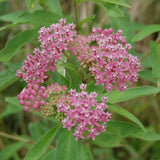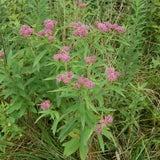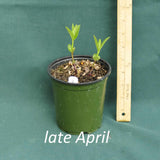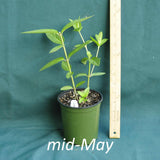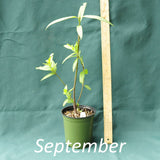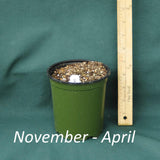Swamp milkweed is one of the best wildlife plants for the garden. Its pink flowers attract pollinators, and its leaves feed the monarch butterfly caterpillar.
- Easy to grow
- Showy in flower
- Monarch host plant
Details
- 3 to 4 ft. tall and wide
- Clump-forming habit that doesn't spread
- Hardy in USDA hardiness zones 5, 6, 7, and 8
Flowering period
In central North Carolina, swamp milkweed flowers for four to six weeks between June and August.
How to grow
Don’t let the name fool you, swamp milkweed is just as happy growing in a moist garden as it is in a swamp. Plants prefer moist, rich soil, but are surprisingly adaptable and can tolerate periodic drought in heavier soil types. Plant in full sun to keep plants compact and make staking unnecessary.
Care and maintenance
Cut down old stems to ground level any time through the winter. Plants in drier soil may need to be watered during periods of drought.
Where to plant
In flower beds, low-lying areas, and at the edges of ponds.
When to plant
It can be planted anytime the ground is not frozen. Plants will grow fast and establish quickly during the heat of summer.
Spacing
3 to 4 ft. apart when planting more than one swamp milkweed in a group.
When will my plant flower?
Plants planted before June will bloom during the summer if planted in a well-prepared site and kept watered.
Native habitat and range
Edges of marshes, bogs, and swamps from Nova Scotia to Georgia.
Source and origin
Plants are grown from seeds collected on the edge of a roadside ditch in Alamance County, North Carolina.
Comments
Asclepias incarnata variety pulchra differs from variety incarnata in that its leaves are pubescent (hairy) and slightly wider. Plants also tend to be less branched (fewer stems) than variety incarnata.
| States | Orders up to $50 | Orders $51 to $100 | Orders over $100 |
| AL, DE, GA, KY, MD, NC, OH, PA, SC, TN, VA, and WV | $16 | $18 | $20 |
| AR, CT, FL, IL, IN, LA, MA, MI, MO, MS, NH, NJ, NY, RI, VT, and WI | $18 | $20 | $22 |
| IA, KS, ME, MN, OK, and TX | $20 | $22 | $24 |
| CO, NE, ND, and SD | $22 | $24 | $26 |
Sorry, we can't ship plants outside of the continental United States or to AK, AZ, CA, HI, ID, NM, NV, OR, UT, and WA due to agriculture restrictions.
When will my order be shipped?All plants are shipped within two weeks of placing an order.
Is it okay to plant in the winter?Yes, as long as the soil is not frozen. Planting native perennials in winter and early spring gives your plants a head start before the summer heat arrives.
What if it’s too cold to plant where I live, but I want to buy a plant before it sells out?Dormant plants can safely be kept in a basement, garage, or cool room until you are ready to plant in late winter or early spring.
How will my plants get delivered?Most orders are shipped on Monday or Tuesday via UPS Ground, which depending on the destination takes between 1 to 4 days.
Are your plants shipped in their containers?Yes, all our plants are shipped in their growing containers. The majority are grown in containers that are 4.5 inches wide by 5 inches deep and 32 fl. oz. / 946 ml in volume.
Do you guarantee your plants?We guarantee our plants to be healthy, ready for planting and correctly named. We are not able to guarantee whether a plant will grow in your garden as there are too many circumstances that are beyond our control.
On rare occasions, a plant shipped dormant may fail to emerge from its dormancy. If this happens, please let us know. If you are concerned about a plant, please contact us within 14 days to let us know. If we can’t help you make it grow, we’ll send you a new plant or issue a refund.
You can return your plants if you no longer want them once they arrive. To receive a refund (minus 20% restocking fee) the plants must be returned in good condition. Return shipping is the customer’s responsibility.
Can I cancel my order?Yes, you can cancel your order. Please visit our terms and service page for details.
What about sales tax?We propagate our own plants and are not required to collect North Carolina sales tax.
Where can I find information about your plants?Here are some FAQ on how we grow plants.







